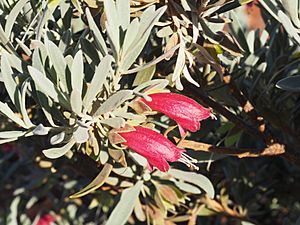Crimson turkey bush facts for kids
Quick facts for kids Crimson turkey bush |
|
|---|---|
 |
|
| Eremophila latrobei latrobei leaves and flowers | |
| Scientific classification | |
| Genus: |
Eremophila (plant)
|
| Species: |
latrobei
|
| Synonyms | |
|
|
The Eremophila latrobei, often called crimson turkey bush, is a beautiful flowering plant. It's also known as native fuchsia or Latrobe's emu bush. This plant belongs to the figwort family, called Scrophulariaceae. It grows only in Australia, meaning it's endemic there.
This plant is a tall, bushy shrub. It has long, narrow leaves and bright red or purple-red flowers. You can find it in all mainland Australian states, including the Northern Territory, except for Victoria.
Contents
What Does the Crimson Turkey Bush Look Like?
The Eremophila latrobei is usually a tall, branched shrub. It can grow from about 0.5 to 4 meters (1.6 to 13 feet) high. Its branches feel rough because of old leaf bases. They are usually smooth, except when they are very young.
The leaves grow one after another along the branches. They can be thin like a thread or shaped like a spear. Most leaves are about 9 to 50 millimeters (0.35 to 2 inches) long. They are also about 0.7 to 3.5 millimeters (0.03 to 0.14 inches) wide.
The Flowers of the Crimson Turkey Bush
The flowers usually grow one by one where the leaves meet the stem. Each flower sits on a short, curved stalk, about 5 to 11 millimeters (0.2 to 0.4 inches) long. There are five green or purple leaf-like parts called sepals. These sepals have fuzzy edges and are about 10 to 19 millimeters (0.4 to 0.7 inches) long. They even get bigger after the flower blooms!
The flower's petals are mostly 20 to 32 millimeters (0.8 to 1.3 inches) long. They join together at the bottom to form a tube. This tube is usually red or purple-red, but sometimes it can be yellow or cream. Both the inside and outside of the tube have tiny, sticky hairs. Four long parts called stamens stick out from the end of the petal tube.
This plant mainly flowers from March to October. After flowering, it produces dry, woody fruits. These fruits are oval or cone-shaped, fuzzy, and about 6.5 to 8 millimeters (0.26 to 0.31 inches) long. They have a thin, sometimes sticky covering.
How Was This Plant Named?
The first official description of the crimson turkey bush was written in 1859. It was described by a scientist named Ferdinand von Mueller. He wrote about it in a report about plants found during an expedition. The plant was named latrobei to honor Charles La Trobe. He was a leader in Victoria from 1851 to 1854.
Different Types of Crimson Turkey Bush
Scientists recognize three main types, or subspecies, of Eremophila latrobei:
- Eremophila latrobei subsp. filiformis: This type has very thin, almost round leaves.
- Eremophila latrobei subsp. glabra: This type has flat leaves and smooth sepals (the green parts under the petals).
- Eremophila latrobei subsp. latrobei: This type also has flat leaves. Its sepals have tiny, branched hairs on the outside.
Where Does the Crimson Turkey Bush Grow?
The subspecies latrobei and glabra are found in many places across Australia. You can see them in Western Australia, the Northern Territory, South Australia, Queensland, and New South Wales. However, in New South Wales, glabra only grows in the far northwest, near Tibooburra.
Both types grow in many different environments. They can be found in various plant communities. Subspecies latrobei often grows in mulga and mallee woodlands. Subspecies glabra prefers sandy plains.
Subspecies filiformis is mostly found in the Hamersley Range. But you can also find small groups of them in other areas. These include the Central Ranges, Gibson Desert, Little Sandy Desert, Murchison, Ord Victoria Plain, Pilbara, and Tanami regions.
Is the Crimson Turkey Bush Endangered?
Good news! All three types of E. latrobei are considered "not threatened." This means they are not currently at risk of disappearing. This classification comes from the Government of Western Australia's Department of Parks and Wildlife.
Growing Crimson Turkey Bush in Gardens
The crimson turkey bush is a popular plant to grow in gardens. Since it comes in different forms, planting a few types together can make a garden look interesting. It also attracts birds that feed on nectar, which is the sweet liquid in flowers.
You can grow new plants from cuttings. This means taking a piece of the plant and helping it grow roots. You can also grow it by grafting. This is when you join a piece of the crimson turkey bush onto the root system of another plant, like a Myoporum. This root system is called a rootstock.
This plant only needs water sometimes. How well it handles frost depends on the specific type you grow. So, it's best to plant it in an area that doesn't get much frost. It can also grow in places with more humidity, but it needs plenty of sunshine.
Images for kids
-
E. latrobei latrobei growing near Mount Augustus
-
E. latrobei filiformis growing near Newman




